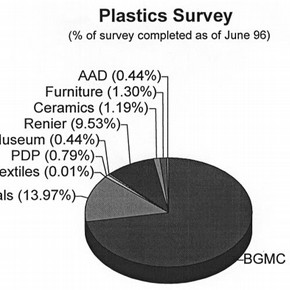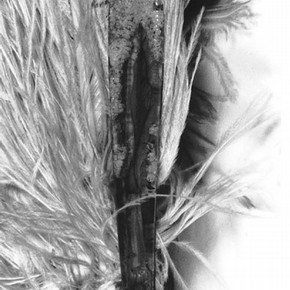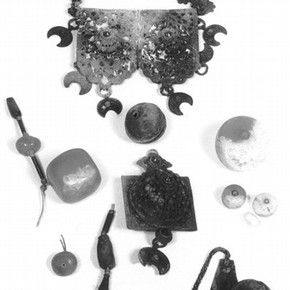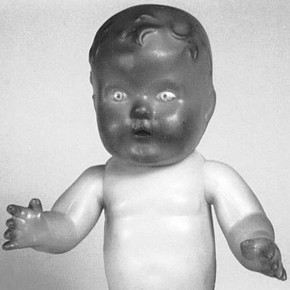Conservation Journal
October 1996 Issue 21
Plastics? Not in My Collection
The Victoria & Albert Museum appointed its first plastics conservator in 1992 with the brief of surveying all the plastic objects within the collections. This mammoth task was started by Dr Edward Then and he reported his progress in an earlier edition of this journal 1 . For the last two and a half years I have been continuing the project and as the person actually undertaking the survey I have come across very many interesting and unusual objects ranging from Cross-eyed Critters in the Renier Collection at Bethnal Green Museum of Childhood to chairs made from recycled plastic detergent bottles in the Furniture & Woodwork Collection, not forgetting such exotica as the stage fans of Beatrice Lillie and the sunglasses of Elton John at the Theatre Museum.
I have also come across interesting and unusual attitudes to the survey, the most common of which I have christened 'plastics denial syndrome', where those in charge will swear blind that there are no plastic objects in their collection and are absolutely astonished when a hidden câche is uncovered. I have attributed this syndrome to the probability that most people mistakenly associate plastics solely with modern living, bearing little relation to the past. Museum collections reflect society throughout history, however, and are influenced by both the fashion and materials technology of the day. As material culture has developed over the last two centuries, a much wider range of objects has been collected and synthetic materials have featured prominently. If we begin with the semi-synthetics, such as cellulose nitrate, we can say that plastics have been around for approximately a century and a half. On this basis it would be unusual if any collection contained no plastics.
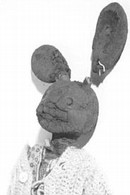
Figure 2. Bendy Bunny Bengy, Museum no. Misc.120-1988. Photography by V&A Photographic Studio (click for larger version)
The results of the survey indicate that although the majority of the objects are in a stable condition, the greatest problem being surface dirt and minor abrasions, there are serious problems with individual plastic materials and these recur regardless of what form the object takes. The polymeric materials giving most cause for concern are:
1. Natural rubber.
2. The early semi-synthetics e.g. cellulose nitrate and cellulose acetate.
3. Polyvinyl chloride (PVC).
4. Polyurethane.
1. Natural rubber. Figure 2 shows 'Bendy Bunny Bengy', (Museum No. Misc.120-1988), a flexible toy made from natural rubber by Bendy Toys in 1951. The rubber has become dry and brittle and crumbles on touch due to oxidation. Natural rubber such as cushioning and textiles in other areas of the collections has undergone similar deterioration.
2. Cellulose nitrate and cellulose acetate. These semi-synthetic materials have been used in a diverse range of applications from mock silk and imitation tortoiseshell haberdashery, to cinema and photographic film. They are inherently unstable and degrade with the subsequent formation of acidic vapours which can cause the disintegration of neighbouring objects. Cellulose nitrate, also known as CelluloidTM (Celluloid Co.), was first produced in the middle of the last century by the nitration of the natural polymer cellulose in the form of cotton. The spontaneous ignition of the material proved to be a problem and stories abound of billiard balls exploding on impact, not to mention the music hall suggestion of eliminating mothers-in-law by lighting up cigars near their Chardonnet silk evening dresses. The problem of flammability was only overcome by replacement with the related material cellulose acetate, which had a low combustibility. Cellulose acetate was not produced on an industrial scale until the mid-1920s. Deteriorating cellulose acetate can generally be distinguished from nitrate by the distinctive aroma of vinegar surrounding the object, as acetic acid is emitted as degradation proceeds.
Figures 3 and 4 illustrate the degradation of cellulose nitrate objects in the Theatre Museum collection. The handle of the Beatrice Lillie fan (Museum No. S327-1979) (figure 3) shows behaviour typical of cellulose nitrate degradation with the material becoming crystalline and opaque. The object illustrated in figure 4, also from the Theatre Museum collection, is a badly degraded cellulose nitrate necklace from the 1922 stage production of Chu Chin Chow. In this case the acidic vapour formed on degradation has caused the textile thread holding the beads to disintegrate completely. A metal component of the necklace has also been attacked, resulting in a bright blue corrosion product.
3. Polyvinyl chloride. Polyvinyl chloride (PVC) was commercially introduced around 1935 and is probably the most adaptable of the synthetic polymers. More than any other polymer it has benefited from the use of additives especially plasticisers and stabilisers, which has given it light and heat stability, and enabled it to be produced with various degrees of flexibility. Loss of plasticiser and darkening in colour are two indications of PVC deterioration and both are visible in figure 5. This doll from BGMC (Museum No. Misc. 98-1987) is extremely sticky where the plasticiser has migrated to the surface and has attracted dust and dirt. Darkening has occurred to the head and limbs where the object was uncovered. This darkening is the result of conjugated double bonds produced either thermally or photochemically and is accompanied by the evolution of hydrogen chloride.
4. Polyurethane foams. The major applications of polyurethane foams are furniture cushioning, mattresses, textiles, carpets, packaging, insulation, toys and sporting goods. Among museum collections they feature predominantly as toys, cushioning and textiles. Figure 6 shows a foam figure of the children's storybook character 'Larry the Lamb' (Museum No. Misc. 97(1)-1978). This figure is one of a set of thirty three polyurethane foam puppets which are in the BGMC collection. These puppets were the stars of the Thames Television series 'Larry the Lamb in Toytown', broadcast in the early 1970s. Several of the puppets are on display in their own case at BGMC and, as figure 6 demonstrates, the foam is literally falling apart. When the case is opened there is an unidentifiable pungent odour 2 . More figures are in storage and any handling produces detachment of the exterior foam as a powder. Oxidation has been confirmed as the cause of this severe deterioration of the polyurethane by analysis of the air in the case. This type of degradation has also been encountered in cushions, toys and other objects made from expanded polyurethane.
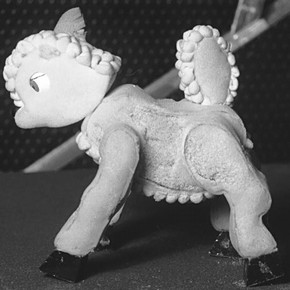
Figure 6. Larry the Lamb. Museum no. Misc.97(1)-1978. Photography by V&A Photographic Studio (click image for larger version)
References
2. Blades, N., V&A Conservation Science Group Report, No. 95/23/NB. 3. Bockris, V., The Life and Death of Andy Warhol, Bantam, New York, 1989.
4. V&A Strategic Plan 1992-1997, p14.
Suggested reading
'Saving the Twentieth Century: The Conservation of Modern Materials', Conference Proceedings, Ottawa, 1991. 'From Marble to Chocolate - The Conservation of Modern Sculpture', Tate Gallery, London, 1995.
October 1996 Issue 21
- Editorial
- Plastics? Not in My Collection
- Plastic, Pop and Mass-produced Design in the V&A's Collections
- Two Pooped-out Pop Chairs: What is the Future for our Plastic Collections?
- An Object Media Enigma
- Milk and Modernism: Conservation of a Smoker's Cabinet designed by Charles Rennie Mackintosh
- 'Sham Columns in a Casing of Crockery'
- Printer Friendly Version
